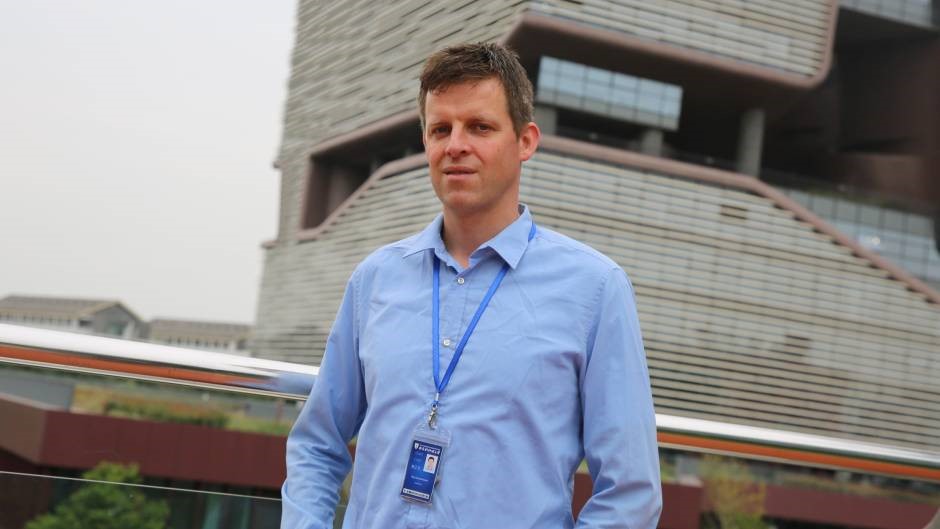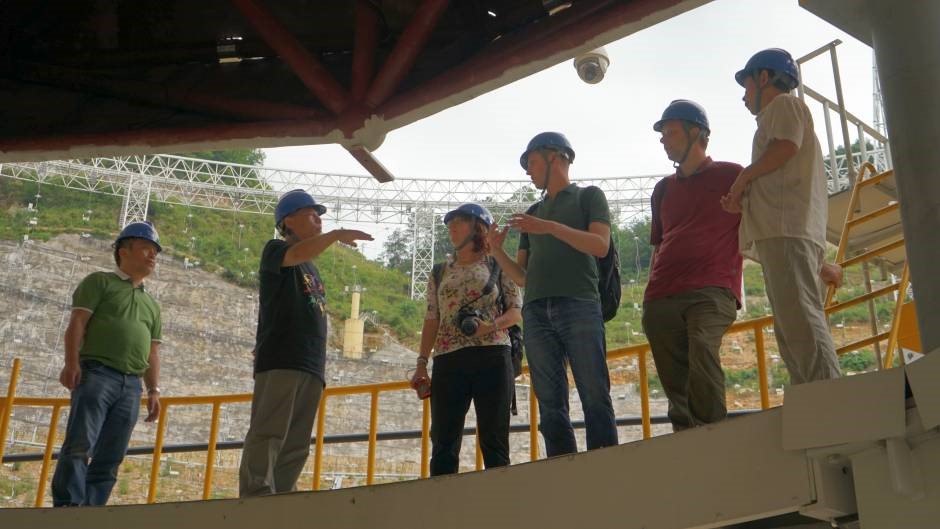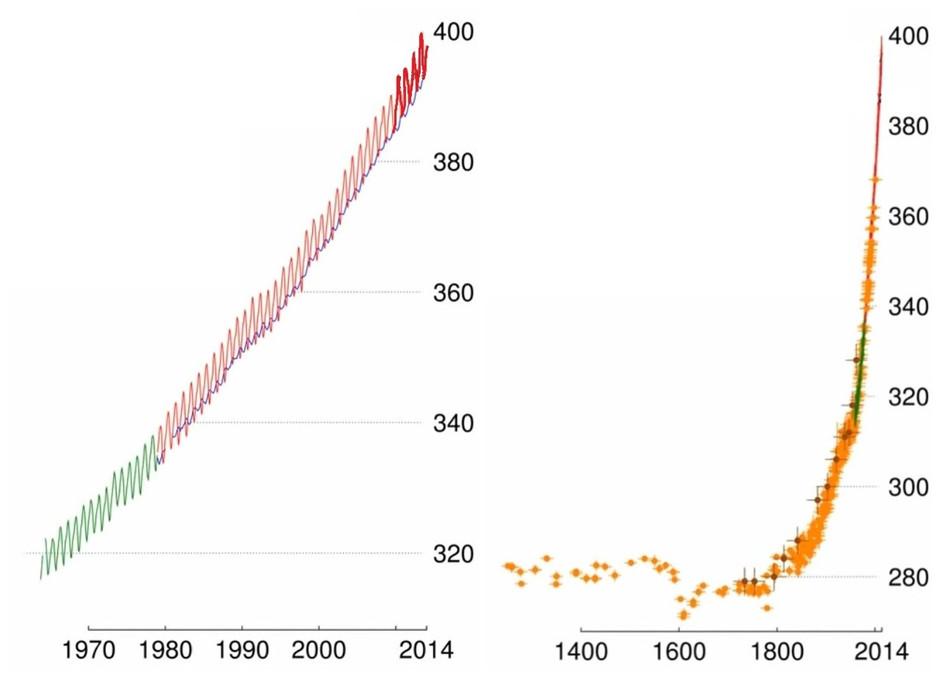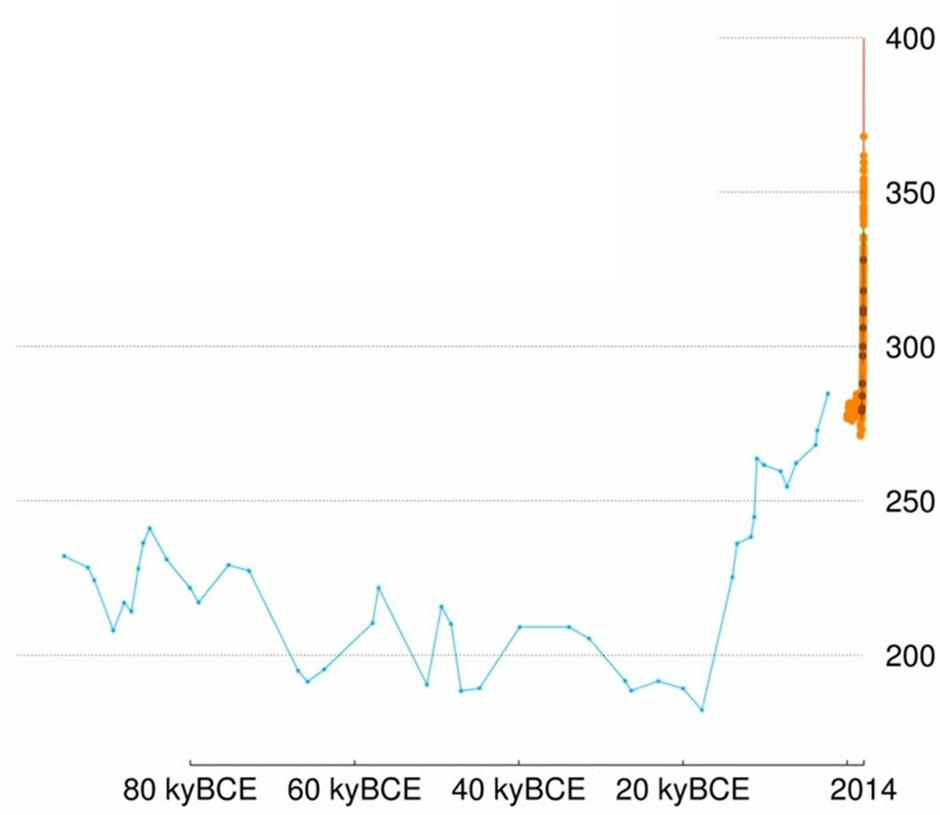25 Oct 2016

Dr Thijs Kouwenhoven is one of China’s experts in the field of astrophysics and a new academic staff member at Xi’an Jiaotong-Liverpool University.
Resident in China for seven years, Thijs (pictured above) contributes frequently to Chinese astrophysics magazine The Amateur Astronomer and is a regular speaker at schools and conferences.
Thijs made a trip earlier this month to the recently-completed Five-hundred-metre Aperture Spherical Telescope (FAST) in Guizhou Province. It is the largest single-dish telescope on the planet and he consulted with Professor Peng Bo (pictured below, second from the left), deputy project manager of FAST, about the progress of construction.

“The telescope is a notable achievement that stimulated many universities in China to start astrophysics research and teaching programmes,” says Thijs.
While in Guizhou Province Thijs helped develop an astronomy curriculum at Qiannan Normal College for Nationalities, located near the county where FAST was built.
"Governments around the world recognise that astronomy is a source of inspiration for children and that it helps motivate them to become scientists or engineers in the future,” he adds.
Background
Mattheus Bartholomeus Nicolaas ‘Thijs’ Kouwenhoven was born in the Netherlands and like many young people became fascinated by the grandeur of the Universe as viewed through a telescope: “Astrophysicists are interested in answering the biggest questions of science,” he says. “Where does the Universe come from? Why is the Earth able to support life? Are we alone in the Universe?”
He completed an undergraduate degree in astronomy at Leiden University and a PhD in astrophysics at the University of Amsterdam, before going on to work for three years as a research associate at The University of Sheffield in the UK.
Hearing about the newly established Kavli institute for Astronomy and Astrophysics at Peking University, Thijs applied for his first academic position in China there.
“I thought this was an excellent opportunity to explore China,” he says. “Peking University is a prestigious place and Kavli is a highly respected institute brand.”
Fred Kavli was a wealthy Norwegian business leader, inventor and philanthropist who set up the Kavli Foundation and research institutes at various prestigious universities throughout the world including Beijing, Cambridge, Tokyo, Caltech and Stanford.
Thijs worked there for seven years teaching and researching astrophysics, and led a research group in planetary science with several PhD students that have recently started their postdoctoral positions abroad.
Research interests
Thijs' main research area is exoplanets - planets beyond our own solar system, of which over 3,500 have been found already.
“Studying exoplanets can shed light on our own planet Earth – on its history and on what may happen to it in the future,” he explains.
One method for detecting exoplanets is to observe eclipses of stars as a planet’s silhouette is observable when it passes in front of a star. Another more complicated method involves close monitoring of the movement of stars to detect the tiny gravitational effects of planets on those stars.
“Other solar systems can be very different from ours, with two or even three stars, and different numbers of planets,” he adds.
He carries out computer simulations to explain how these planetary systems are formed, and movements and activities within them, including the climates of planets. "My computer is my research laboratory," he says.
The computer programs that Thijs has developed can also simulate impact collisions, such as that of an asteroid on a planet, which caused the dinosaurs’ extinction on Earth.
Astrophysics matters here on Earth
“Astronomy is not just about looking at the stars,” explains Thijs. “In addition to the pure scientific interests, astrophysics and space science bring in new technology that can be applied in many other aspects of our lives.”
One area of scientific endeavor which astrophysics contributes to is that of understanding climate change.
Billions of years ago, the planets Mars and Venus likely hosted oceans. However, their atmospheres have become uninhabitable due to climate change. The frozen planet Mars has a ‘failed greenhouse effect’, while the boiling planet Venus a ‘runaway greenhouse effect’.
“Climate change deniers are correct about one thing: The temperature of the Earth has always been changing,” explains Thijs. “There were pre-historic fluctuations in the Earth’s temperature due to many factors including changes in the orbit of the Earth around the Sun, the Earth’s tilt, and geological factors.”
Carbon dioxide levels from Earth’s distant past have been calculated by studying the ice caps at Greenland and the South Pole (see graphs below).
“The studies reveal that none of the past temperature fluctuations were as rapid as the current temperature rise, which is due to human activity,” says Thijs.


Graphs showing changes in Earth’s levels of atmospheric CO2 (parts per million) going back decades, centuries and millennia (courtesy of the NOAA).
In December 2015, Thijs spoke at a climate change and health symposium at XJTLU, where experts from various fields concluded that mankind is responsible for Earth’s current temperature rise, but is also the key to finding a solution to climate change.
The future
Thijs plans to continue his research in astrophysics and space science and to establish a course in Astronomy at XJTLU, with a field trip to FAST just one of the many exciting prospects for students.
“I’m currently teaching mathematics courses and next semester I will teach physics,” he says. “In the future I hope to teach higher-level physics courses in the future, including astrophysics and space science.”
He plans to recruit PhD students here at XJTLU to work on planetary science projects and to cooperate with the Departments Environmental Science and the Computer Science and Software Engineering to make more detailed climate simulations.
*Image credits in the video:
1. S. Beckwith (STScI) Hubble Heritage Team, (STScI/AURA), ESA, NASA;
2. Planetary Habitability Laboratory, UPR Arecibo;
3. Bill Saxton, NRAO/AUI/NSF;
4. Tim Pyle, NASA;
5. NASA, ESA, and the Hubble Heritage Team (STScI/AURA)-ESA/Hubble Collaboration
25 Oct 2016




